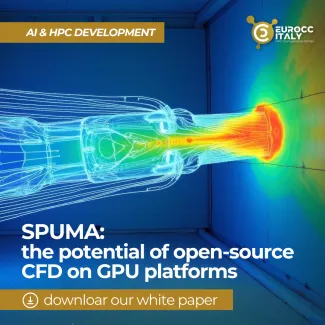
SPUMA – Simulation Processing on Unified Memory Accelerators is an open-source software for CFD (Computational Fluid Dynamics) simulation. It leverages a shared memory space to run complex simulations more efficiently, fully harnessing the power of GPU platforms.
With SPUMA, a Breakthrough in Fluid Dynamics
Computational Fluid Dynamics (CFD) makes it possible to simulate the behavior of fluids (air, water, gas) and other complex physical phenomena by “predicting” how a system will perform through mathematical models. This significantly reduces the need for costly experimental tests, which are often difficult or even impossible to carry out in a laboratory setting.
One of the most widely used software packages in the field of Computational Fluid Dynamics (CFD) is OpenFOAM. Thanks to its open-source nature, modular structure, and the large international community that drives its development, it is widely used in high-tech industrial sectors such as automotive, aerospace, energy, and climate control.
SPUMA is an advanced version of the OpenFOAM software, designed to leverage the acceleration of modern graphics cards (GPUs). Thanks to Unified Memory, a hardware/software architecture that allows the CPU and GPU to access a shared memory space, it simplifies and speeds up data processing.
SPUMA originates from the European project exaFOAM and marks a groundbreaking milestone, as it enables, for the first time, stable and scalable execution of this software on GPUs—paving the way for faster and more cost-effective high-fidelity simulations.
The Advantages of SPUMA
✅ Open Source
✅ Interface Modularity
✅ Cross-Platform Compatibility
✅ More Power
✅ Faster Response Times
✅ Lower Resource Consumption
✅ Energy Savings
✅ Reduced Costs
An Opportunity for Businesses
SPUMA represents a concrete opportunity for companies looking to enhance their simulation capabilities while keeping costs under control. As an open-source software, it involves no licensing fees while still ensuring high computational efficiency.
The potential of SPUMA extends across numerous sectors: automotive (optimization of vehicle aerodynamic performance); aerospace industry (external aerodynamics studies, thermal load assessment, and propulsion system optimization); renewable energy (design of wind turbines and solar power systems); HVAC and plant engineering (optimization of airflow and temperature distribution inside buildings); education and research (advanced numerical experiments).
Want to know more?
Download the white paper explaining the technical features of SPUMA and its application cases.
Discover the resources repository.
How SPUMA Works
GPUs, the core of SPUMA’s architecture, enable the execution of complex simulations much faster than traditional CPUs. A single GPU card can replace hundreds of CPU cores, drastically reducing computation time and the resources required. This results in faster response times and significant energy savings.
SPUMA also makes it possible to tackle simulations that were previously prohibitive due to technical or economic constraints. Thanks to improved scalability and reduced complexity in domain partitioning management, it allows for more agile handling of simulations involving hundreds of millions of cells. This paves the way for high-fidelity analyses that are closer to the physical reality of the problem, leading to more accurate and reliable results. The ability to integrate external linear algebra libraries, such as NVIDIA’s AMGX, makes the software even more versatile and high-performing, including in experimental settings.